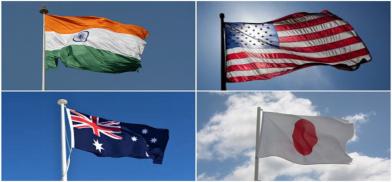Time to strengthen Quad to counter China’s influence
There is a geopolitical dimension to the COVID-19 tsunami that continues to leave in its wake thousands of deaths across the world

There is a geopolitical dimension to the COVID-19 tsunami that continues to leave in its wake thousands of deaths across the world. The pandemic, which is expected to see a spike in the coming months, will be re-energising Asia’s geopolitical equations with sweeping global ramifications.
Amid China’s aggressive economic and diplomatic postures – as is reflected in its Belt and Road Initiative (BRI) – India is embedding itself deeply in a revived form of Quadrilateral Security Dialogue known as the Quad. Others in the informal grouping are the United States, Japan, and Australia.
There is nothing to lose but gain from Quad, which was originally mooted in 2007 by Japanese Prime Minister Shinzo Abe. Now it is getting a new lease of life following the pandemic that has deepened the trust deficit with China following its attempts to keep under wrap for several months the virus that erupted in Wuhan last year.
For India, the Quad is a very good way to ensure that China does not gain the upper hand despite its continued nexus with Pakistan, says Parag Khanna, an Indian American expert in international relations and a best-selling author.
In an interview to South Asia Monitor, he said the Quad is a very good way to counter Beijing’s hegemonic ambitions, especially after the COVID-19 pandemic that revealed President Xi Jinping’s naked authoritarianism.
“The Communist Party is purely self-interested and now wants to appear to be a savior,” Khanna said.
Besides authoring four books on global geopolitics and geoeconomics, he had advised the US National Intelligence Council's Global Trends 2030 Program, which published an insightful report, Alternative Worlds. He is Founder and Managing Partner of FutureMap, a data and scenario-based strategic advisory firm.
Khanna says that over the past several years, India’s diplomatic initiatives have been gaining more thrust and assertiveness. This was demonstrated particularly after the Doklam standoff in June 2017 when Indian troops stopped the Chinese army from constructing a road at the India-Bhutan-China trijunction at Doklam.
It was in Wuhan that Prime Minister Narendra Modi and President Xi Jinping had held what was described as ‘informal’ consultations to resolve the 73-day standoff, the most serious flare-up since 1987.
India said the Doklam issue was resolved through “diplomatic maturity without losing any ground.” New Delhi said there was no change in the status quo and the meeting created a conducive environment to ensure “mutual comfort, mutual understanding, and mutual trust.”
The issue was over China’s attempted road construction activity at the tri-junction among India, China, and Bhutan, which Delhi asserted could impact its security by undermining the connectivity between the Northeast and the rest of India.
“China, of course, has not changed its geopolitical postures,” said Khanna. The Doklam standoff demonstrated India’s muscular foreign policy under the Modi government. “In the past several years, India has witnessed an awakening as to China’s aggressive posture,” he noted.
Khanna adds: “As most Asians live in democracies with a high degree of relative transparency, they will not be convinced by Chinese propaganda. They will remain suspicious of Chinese motivations.”
He thinks that financing Eurasian infrastructure integration for mutually beneficial purposes is a good idea, and India should think of reinforcing its presence by devising its own strategy to counter Chinese influence.
It can do so without joining China’s BRI but through greater partnership to finance connectivity with Japan, the US, Europe and others.
“China does not have a monopoly on infrastructure finance nor engineering,” he said.
The US-Japan-India-Australia “Quad” emerged out of 2004 tsunami crisis to address increasing trade protectionism. Today, the pandemic presents an opportunity for the Quad to work on a new pan-Asian institutional architecture to counter China’s aggressive political and economic diplomacy.
For Washington, this is an opportunity to regain lost ground as a leader of the free world and recover its lost face following the way President Donald Trump handled the pandemic. This presents an opportunity to demonstrate to its allies its leadership and assert that it has not collapsed and is capable of engaging with belligerents.
As US Secretary of State Mike Pompeo had once said one of Quad’s purposes was to restrain Chinese hegemony. “This will prove very important in the efforts ahead, ensuring that China retains only its proper place in the world.”
(The writer is Senior Fellow, SPS. The views expressed are personal. He can be contacted at ksnayar@spsindia.in)









Post a Comment